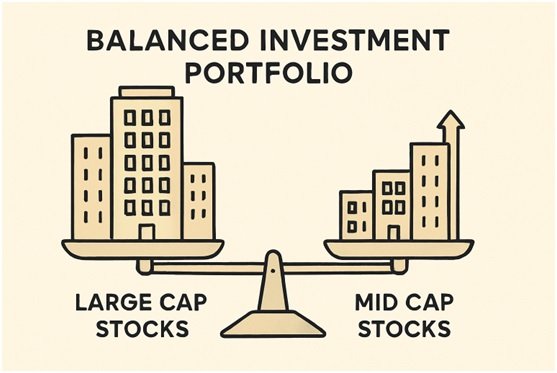
Benefits of Diversifying Your Portfolio with Mid and Large Cap Stocks
Introduction
Building a resilient investment portfolio requires purposeful allocation across different types of assets. One effective strategy is to diversify between mid- and large-cap stocks. By blending these two categories, you can strike a balance between the established stability of market giants and the dynamic growth prospects of expanding firms. To further understand how to implement this approach and maximize your returns, consider the resource https://trueplatform.com/asset-class/mid-large-cap/, which provides in-depth guidance on allocating mid- and large-cap assets.
This approach offers the best of both worlds, combining reliable, dividend-paying companies with agile corporations ready to capitalize on emerging opportunities. Learning how to harness the unique strengths of each market cap category can help you weather market volatility and position yourself for long-term gains.
Understanding Market Capitalization
Market capitalization, also known as “market cap,” is a key metric used to classify companies based on their total market value, which is determined by multiplying the current share price by the total number of outstanding shares. This value helps investors group stocks by size:
- Large Cap: Companies with a market capitalization exceeding $10 billion. These are generally industry leaders with global reach.
- Mid Cap: Firms with a market capitalization between $2 billion and $10 billion. These companies are often past their start-up phase and demonstrating solid growth trajectories.
Each category bears its own risk-reward profile, forming the foundation of a strong diversification strategy.

Advantages of Large-Cap Stocks
Large-cap stocks represent some of the most established and recognizable names in the market. Investors often turn to these giants for several reasons:
- Stability Through Scale: Large-cap companies often have diverse revenue streams, global operations, and deep resources, enabling them to withstand market downturns and economic uncertainty.
- Dividend Reliability: Many pay regular dividends, providing investors with passive income in addition to any share price appreciation.
- High Liquidity: Their shares are actively traded, making it easy to buy or sell positions efficiently even in volatile markets.
This class of stocks generally appeals to conservative investors seeking reliability and consistent returns.
Growth Potential of Mid-Cap Stocks
Mid-cap stocks, while smaller than their large-cap counterparts, are frequently in the most exciting phase of their business life cycle. The benefits of including mid-caps in your portfolio include:
- Enhanced Growth Prospects: Many mid-cap firms have matured beyond the high-risk early stage but still possess ample room for expansion both domestically and internationally. Their agility enables them to capitalize on emerging trends quickly.
- Adaptability: Unlike large conglomerates, mid-caps can pivot and innovate more rapidly in response to shifting market conditions, consumer tastes, or technological disruptions.
The historical performance of mid-caps illustrates their ability to deliver superior returns, making them an attractive choice for investors seeking growth.
Balancing Risk and Reward
Diversification isn’t just about spreading assets; it’s about mixing them in a way that optimizes performance while cushioning portfolio swings. A portfolio combining large- and mid-cap stocks can:
- Smooth Volatility: Large caps anchor your portfolio during rough markets, while mid-caps provide an engine for long-term outperformance.
- Exploit Market Cycles: During growth periods, mid-cap stocks often outpace their larger peers. During economic slowdowns, large-cap stocks help preserve capital and provide regular dividends, resulting in more consistent returns over time.
Sector Diversification Benefits
Mixing companies across market caps naturally broadens industry exposure. Large-cap stocks tend to dominate mature industries such as finance, healthcare, and consumer staples, providing safety and familiarity. Meanwhile, mid-cap companies often drive innovation in emerging sectors, such as technology, green energy, and biotech. This sectoral mix not only captures different growth trends but also mitigates the risks associated with any single industry’s fortunes.
Historical Performance Insights
Data reinforces the value of diversifying with mid- and large-cap stocks. Over the period from 1991 to 2024, the S&P MidCap 400 Index yielded a total return of 985%, handily beating both the S&P 500’s 563% and the Russell 2000’s 608%. These results highlight why incorporating a meaningful allocation to mid-caps could dramatically boost long-term portfolio performance. ([investopedia.com](https://www.investopedia.com/mid-cap-long-term-returns-5225971?utm_source=openai))
Implementing a Diversified Strategy
- Assess Your Risk Tolerance: Consider how comfortable you are with market fluctuations and determine whether your primary goal is stability, growth, or a mix of both.
- Strategically Allocate Assets: Decide your ideal blend of mid- and large-cap stocks. Younger, risk-tolerant investors may favor mid-cap stocks, while those nearing retirement might prioritize large-cap stocks for safety.
- Select Suitable Investments: You can build your allocation with individual stocks or turn to mutual funds and ETFs focused on mid- or large-cap equities to achieve instant diversification.
Review and rebalance your investments periodically to ensure they stay in line with evolving financial goals or shifting market conditions.
Monitoring and Adjusting Your Portfolio
Investment is not a one-time decision. Monitor performance regularly to stay informed about significant market or life changes. Rebalance when allocations drift from your targets due to market movements. Review sector and market cap allocation annually to make adjustments that reflect your investment objectives, time frame, and risk profile.
Leveraging both mid- and large-cap stocks offers a comprehensive approach for contemporary investors. By understanding how each contributes to your portfolio and making adjustments in line with performance and personal needs, you can better weather market instability and seek sustained, long-term growth.


